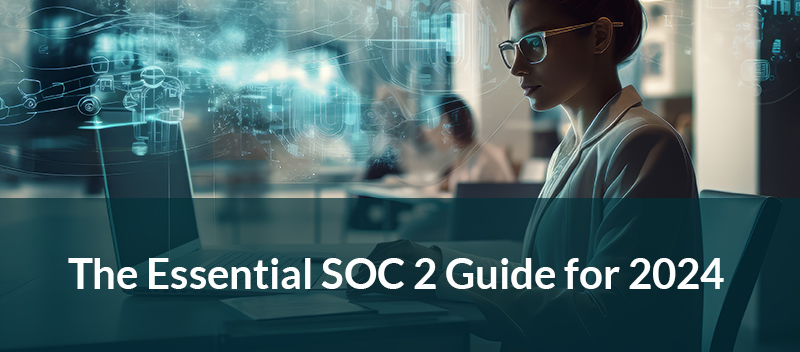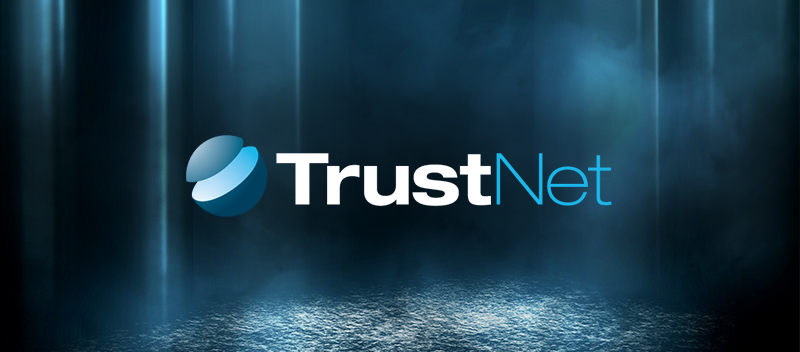Decoding SOC 2: The Essential Guide for 2024

SOC 2 reports allow companies to showcase the measures they’ve implemented for handling data and infrastructure to current and potential clients. In a time when data breaches are frequent, achieving SOC 2 compliance is vital for fostering confidence among customers and stakeholders.
This guide aims to illuminate the importance of SOC 2 compliance, provide clear insights on its components, and equip you with the knowledge needed to secure your business effectively in this digital age.
Understanding SOC 2 Compliance
SOC 2 compliance is meeting the standards the American Institute of Certified Public Accountants (AICPA) sets for managing customer data. This management is evaluated based on five Trust Services Criteria.
Achieving SOC 2 compliance signifies that a company has established robust data protection measures and adheres to them consistently and effectively. SOC 2 compliance assists businesses in setting up and maintaining stringent data protection standards, fostering confidence with their customers and stakeholders.
Initially, the focus of SOC 2 audits was primarily on physical and technical controls. However, the need for more comprehensive oversight and robust data management controls became apparent with the rise of cloud services and third-party vendors.
This shift led to the evolution of SOC 2 into a more encompassing framework that not only focuses on security but also considers a system’s availability, processing integrity, confidentiality, and privacy.
For more on our SOC 2 compliance services Click Here
Key Elements of SOC 2 Compliance
SOC 2 Compliance is structured on five core “trust service principles,” namely security, availability, processing integrity, confidentiality, and privacy.
— Security. Information and systems are protected against unauthorized access, unauthorized disclosure of information, and damage to systems that could compromise the availability, integrity, confidentiality, and privacy of information or systems and affect the entity’s ability to achieve its objectives.
Security refers to the protection of
- information during its collection or creation, use, processing, transmission, and storage, and
- systems that use electronic information to process, transmit, transfer, and store information to enable the entity to meet its objectives. Controls over security prevent or detect the breakdown and circumvention of segregation of duties, system failure, incorrect processing, theft or other unauthorized removal of information or system resources, misuse of software, and improper access to or use of, alteration, destruction, or disclosure of information.
— Availability. Information and systems are available for operation and use to meet the entity’s objectives.
— Processing Integrity. System processing is complete, valid, accurate, timely, and authorized to meet the entity’s objectives.
— Confidentiality. Information designated as confidential is protected to meet the entity’s objectives. Confidentiality addresses the entity’s ability to protect information designated as confidential from its collection or creation through its final disposition and removal from the entity’s control in accordance with management’s objectives.
— Privacy. Personal information is collected, used, retained, disclosed, and disposed of to meet the entity’s objectives.
Why SOC 2 Compliance is Crucial for Businesses in 2024
There are several vital reasons why SOC 2 compliance is crucial for businesses:
Trust and Confidence: SOC 2 compliance demonstrates to customers and stakeholders that your business takes data security seriously. This commitment can help build trust and confidence in your brand.
Risk Mitigation: Adhering to the five trust service principles helps mitigate the risk of data breaches and cyberattacks, protecting your business from financial loss and reputational damage.
Regulatory Requirements: In many industries, particularly those dealing with sensitive information such as finance and healthcare, SOC 2 compliance is a regulatory requirement.
Competitive Advantage: In a marketplace where data security is growing, being SOC 2 compliant can give your business a competitive edge.
Meanwhile, non-compliance with SOC 2 can have severe consequences for businesses:
Financial Penalties: Businesses may face fines for non-compliance, especially in regulated industries.
Loss of Customer Trust: If a data breach occurs due to inadequate security measures, businesses can lose the trust of their customers, potentially leading to loss of business.
Reputational Damage: Non-compliance can result in significant reputational damage, which can be hard to recover from and impact future business prospects.
Overall, SOC 2 compliance is more than just a regulatory requirement; it’s a critical part of a company’s commitment to data security and customer trust.

How SOC 2 Compliance Impacts Different Business Sectors
SOC 2 compliance plays a crucial role across various business sectors, particularly those that handle sensitive data. The impact of SOC 2 compliance varies depending on each industry’s specific needs and regulatory requirements.
Information Technology (IT)
In the IT sector, companies must demonstrate SOC 2 compliance to assure clients that their data is handled securely. SOC 2 certification boosts client trust and gives the business a competitive edge in the market.
Finance
Financial institutions like banks and fintech companies handle sensitive customer data, including financial transactions and personal identification information. Therefore, SOC 2 compliance is vital to assure customers that their financial data is securely processed and stored.
Healthcare
Healthcare organizations handle susceptible patient data, making SOC 2 compliance critical. SOC 2 ensures that patient data is protected and confidentiality is maintained. This compliance is essential to operate and maintain the trust of healthcare providers and patients.
E-commerce
Within e-commerce, companies manage a significant volume of client data, encompassing transaction details and personal information. Adherence to SOC 2 standards guarantees secure storage and handling of this customer data, a critical factor in fostering customer confidence and facilitating seamless business procedures.
Education
Educational institutions and EdTech companies also deal with sensitive student data. SOC 2 certification demonstrates to schools and universities that student data is handled with integrity and confidentiality, which is crucial for maintaining institutional partnerships and student trust.
Steps to Achieve SOC 2 Compliance
Embarking on the SOC 2 audit journey may seem daunting due to its complexity. However, thoroughly understanding its primary stages can help simplify the procedure. Let’s delve into a comprehensive analysis of what businesses might encounter during a SOC 2 audit:
Phase 1 – Readiness Assessment: (3 to 6 Weeks)
This initial stage involves both onsite and offsite evaluations. The aim is to assess the current state of your organization’s systems and controls. This readiness assessment allows the identification of potential gaps or weaknesses in areas such as documentation of policies and procedures, system configuration, audit trails, and usage of technical resources. This phase serves as a diagnostic tool to prepare your organization for the later stages of the audit.
Phase 2 – Remediation: (2 to 8 Weeks)
Following the initial assessment, this phase addresses the identified issues. This is the time to execute the necessary changes to rectify the discrepancies in the readiness assessment. These modifications can involve using various technical resources, implementing new or revised procedures, creating or updating documentation of policies and procedures, altering system configurations, and ensuring the retention of audit trails by preserving evidentiary elements. This stage is crucial as it prepares the client for the final evaluation.
Phase 3 – Assessment and Reporting: Type 1: (4 to 6 Weeks) Type 2: (7 months)
This final stage requires an onsite evaluation to demonstrate the rectifications’ effectiveness during the remediation phase. This includes a primary and secondary round of testing to ensure that the implemented changes have effectively addressed the previously identified gaps. The results of these tests are then documented in a detailed report. This report will determine whether the organization has successfully met the criteria for SOC 2 certification.
It’s important to note that a SOC 2 audit isn’t just a one-off event but a perpetual data security commitment. Regular monitoring and ongoing improvements are essential in keeping up with compliance and protecting the interests of your stakeholders.
Common Challenges in Achieving SOC 2 Compliance and How to Overcome Them
Achieving SOC 2 compliance might seem daunting due to several common challenges. However, with the right strategies, these hurdles can be overcome effectively.
Understanding the Scope: The SOC 2 framework is extensive and complex, making it difficult for organizations to understand its intricacies. Organizations should consider hiring a qualified expert like TrustNet, who specializes in SOC 2 compliance, to overcome this.
Resource Constraints: Many organizations struggle with limited resources, both in terms of personnel and time. This can make achieving SOC 2 compliance challenging. To manage this, prioritize tasks based on their importance and allocate resources accordingly. Consider outsourcing some functions to trusted third parties if necessary.
Maintaining Continuous Compliance: SOC 2 is not a one-time certification but requires ongoing compliance. This can be overwhelming for organizations. Implementing a continuous monitoring program and setting up regular internal audits can help maintain compliance over time.
Data Management: Ensuring all data is secure and managed correctly can be challenging. Organizations can address this by implementing robust data management policies and procedures, including encryption and access controls.
Change Management: Rapid changes in technology and business processes can make it challenging to maintain SOC 2 compliance. To mitigate this, establish a robust change management process that includes regular reviews and updates to policies and procedures.

How TrustNetInc Can Help Your Business with SOC 2 Compliance
TrustNetInc is a leading cybersecurity and compliance service provider committed to assisting businesses achieve and maintain SOC 2 compliance. Our team of experts can guide your organization through the complexities of the SOC 2 framework, ensuring that you meet industry standards for data security.
Our work with renowned companies like Calendly and ExperiencePoint showcases how we can significantly contribute to your business’s success.
Calendly’s Success Story
Calendly, a globally recognized CRM and meeting scheduling company, engaged with our team to implement the NIST Risk Assessment, HIPAA, SOC 2, and ISO 27001 protocols.
These measures helped Calendly identify and prioritize potential cybersecurity threats, leading to improved compliance with industry regulations. This attracted new customers and business partners and boosted the existing customers’ confidence levels.
The success story of Calendly and TrustNet illustrates how proper cybersecurity measures can significantly contribute to a business’s growth and success.
ExperiencePoint’s Achievement
ExperiencePoint, a global leader in innovation training, recently completed a Service Organization Control SOC 2 Type 1 Assessment audit with the help of TrustNet.
David Haapalehto, ExperiencePoint’s Director of Project Management and Process Optimization, expressed his delight over the certification, stating it would bolster clients’ confidence in their capacity to protect personal and organizational data.
This achievement underscores ExperiencePoint’s commitment to centering client needs in their work and is a testament to TrustNet’s role in guiding organizations toward robust cybersecurity practices.
In both instances, TrustNet played a crucial role in conducting the SOC 2 audit, solidifying its position as a trusted partner in achieving regulatory compliance and enhancing internal control environments.
Final Thoughts: Navigating the Path to SOC 2 Compliance in 2024
The year 2024 will bring about an increased emphasis on cybersecurity and data protection. In this digital landscape, SOC 2 compliance is no longer a luxury but a necessity for businesses that handle sensitive customer data.
Achieving SOC 2 compliance ensures that your organization adheres to industry standards and builds trust with your clients and stakeholders. Overcoming the challenges of achieving SOC 2 compliance may seem daunting, but it’s definitely within reach with the right strategies, resources, and partners.
To facilitate your journey towards SOC 2 compliance, we invite you to download TrustNet’s SOC 2 Essential Guide. This comprehensive guide provides insights, tips, and strategies to effectively navigate the SOC 2 compliance process.
For further assistance or any queries, please feel free to contact us. Our team of experts is always ready to help you enhance your cybersecurity defenses and achieve




